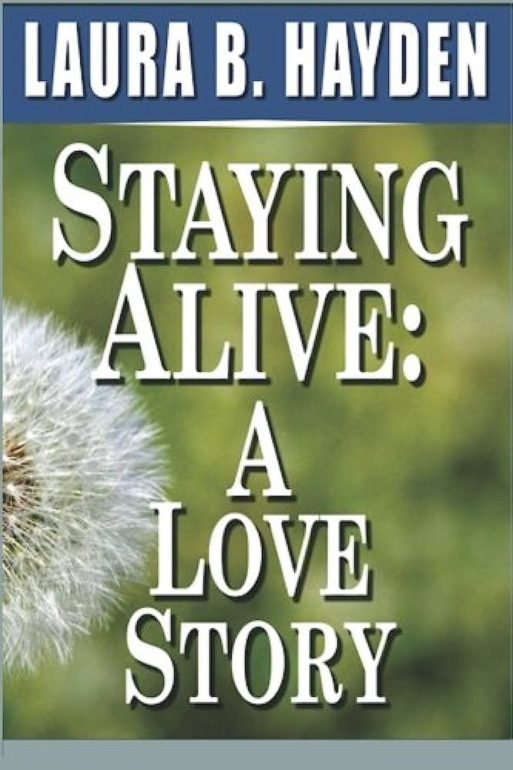 “Staying Alive: A Love Story” by Laura B. Hayden, is part love story, part memoir. A short book, just 125 pages long, it tells the story of a woman facing sudden widowhood after the unexpected death of her husband from a blood clot that lodged in his lung. The deadly clot came just two weeks after cardiac bypass surgery, while Larry, Laura’s husband, was recuperating at home. It, and Larry’s death, rocked Laura and her family to its core.
“Staying Alive: A Love Story” by Laura B. Hayden, is part love story, part memoir. A short book, just 125 pages long, it tells the story of a woman facing sudden widowhood after the unexpected death of her husband from a blood clot that lodged in his lung. The deadly clot came just two weeks after cardiac bypass surgery, while Larry, Laura’s husband, was recuperating at home. It, and Larry’s death, rocked Laura and her family to its core.
The story opens with Larry’s death in the Emergency Room at the local hospital, where he was taken by ambulance after collapsing at home. Filled with raw emotion, these first few pages eloquently convey the family’s terror and disbelief at his sudden, unexpected death.
From there, Laura takes us on a journey through time, skipping back and forth between long ago events: some joyous, some tragic, some bittersweet. She writes about her and Larry’s first dog — a little Westie puppy named Piper — and the child she conceived and then miscarried in the early years of their marriage. She tells us about her second, full-term pregnancy, and giving birth to Connor, who is so much like his dad that he even loves the same book, “Make Way for Ducklings” that Larry loved as a child. Later, she and Larry have another child, Emily, and their family is complete.
Much later in “Staying Alive,” Laura talks about her children’s struggles in the wake of her husband’s death. Connor, unprepared as he was for his sudden role as the “man of the house” seems to adjust well, albeit slowly. A thoughtful, intelligent boy, he is chosen to speak at the closing ceremony for D.A.R.E., a police-sponsored forum for kids about how to avoid drugs and alcohol, just months after his father’s death. There, he shocks his mom by beginning his speech with the words “I have too good a life to waste with drugs or joining gangs.” (“Too good a life?” Laura thinks to herself. “Really?”) He then goes on to explain, “Sure, I’ve had some things happen to me that I wish didn’t, but if I thought drugs could help me get my mind off that, I couldn’t be more wrong.” Instead, he says, “I turn to my family and friends.”
Emily’s grief journey is a bit rockier. Emotionally shut down and aloof, she refuses to speak to the psychologist recommended by her pediatrician, writing four years later in her college application essay, “I couldn’t figure out what would inspire me to pour out my feelings to this doctor if I wouldn’t do so with my own mother” (a valid point!). Yet she also writes pointedly about the real reason she didn’t want to talk about her father’s death: “…the word ‘died’ sent chills through my body. I didn’t want to say it….Saying it meant it really happened. I lived each day clinging to the hope that maybe it was a dream, and soon I would wake up to the sound of his voice warning me that I needed to get out of bed before I missed the school bus.”
Emily was in denial. And it took a long time, and the death of a schoolmate, to help her begin to come to terms with the reality that denying the truth culd only protect her from the pain of loss for so long.

Laura B. Hayden, author of “Staying Alive: A Love Story”
As “Staying Alive” unfolds, Laura also learns that she has a malignant tumor on her kidney. Fortunately, the tumor is encapsulated and, along with her kidney, is completely removed. “How terrifying that must have been,” I thought to myself as I read this. But Laura, perhaps unable to articulate her fear or even acknowledge it even long after the fact, writes about the event with remarkable aplomb.
In fact, the only missing element in this otherwise beautiful book is a sense of Laura’s emotional response to her husband’s death. She writes about her children, and in reading about their pain, we see their mother’s pain as well. But it’s not until the end of the book, when Laura writes about the death of her mother (her father died long before) that some of the sadness and anger and terrible sense of abandonment that the young widow felt as she grappled with the sudden death of the man she loved came through. But maybe that’s fitting — maybe a 48-year-old wife and mother, suddenly thrust into the role of a single parent of two grieving children and the sole support of her family, had little time to think about or even acknowledge how she felt. Or maybe dealing with the day to day demands of running a household and raising two children was her way of dealing with her grief.
But in the end, when Laura does allow the reader a glimpse of what he loss of her husband really meant to her, it adds a missing dimension to the book. This is especially true when she shares the words of Dr. William Petit, a Connecticut physician whose wife and two daughters were murdered in 2007. Speaking of grief, Petit calls those who say there is “closure” after the death of a loved one “imbeciles,” adding: “There’s never closure. There’s a hole…it’s a hole with jagged edges, and over time the edges may smooth out a bit, but the hole in your heart and the hole in your soul is still there.”
And with those words, we understand that Laura’s grief was still with her as she wrote “Staying Alive” nearly a decade after her husband’s death. And, I’m sure, it is still with her — though lessened in intensity — today. Because there is no closure for anyone — not really. The best we can hope for is the comfort of remembering — through the filters of time and space — a deeply felt love.
Editor’s note: Laura Hayden is a writer for SevenPonds.

 “Staying Alive: A Love Story” by Laura B. Hayden
“Staying Alive: A Love Story” by Laura B. Hayden



 Neil deGrasse Tyson Prompts Ruminations on Life & Death in New Year
Neil deGrasse Tyson Prompts Ruminations on Life & Death in New Year
 “I Will Remember You” by Sarah McLachlan
“I Will Remember You” by Sarah McLachlan














